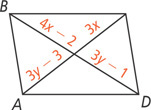6-3 Proving That a Quadrilateral Is a Parallelogram
Quick Review
A quadrilateral is a parallelogram if any one of the following is true.
- Both pairs of opposite sides are parallel.
- Both pairs of opposite sides are congruent.
- Consecutive angles are supplementary.
- Both pairs of opposite angles are congruent.
- The diagonals bisect each other.
- One pair of opposite sides is both congruent and parallel.
Example
Must the quadrilateral be a parallelogram?

Yes, both pairs of opposite angles are congruent.
Exercises
Determine whether the quadrilateral must be a parallelogram.
Algebra Find the values of the variables for which ABCD must be a parallelogram.
6-4 Properties of Rhombuses, Rectangles, and Squares
Quick Review
A rhombus is a parallelogram with four congruent sides.
A rectangle is a parallelogram with four right angles.
A square is a parallelogram with four congruent sides and four right angles.
The diagonals of a rhombus are perpendicular. Each diagonal bisects a pair of opposite angles.
The diagonals of a rectangle are congruent.
Example
What are the measures of the numbered angles in the rhombus?

Exercises
Find the measures of the numbered angles in each special parallelogram.
Determine whether each statement is always, sometimes, or never true.
- A rhombus is a square.
- A square is a rectangle.
- A rhombus is a rectangle.
- The diagonals of a parallelogram are perpendicular.
- The diagonals of a parallelogram are congruent.
- Opposite angles of a parallelogram are congruent.
Table of Contents
- 6-1 The Polygon Angle-Sum Theorems
- 6-2 Properties of Parallelograms
- 6-3 Proving That a Quadrilateral Is a Parallelogram
- 6-4 Properties of Rhombuses, Rectangles, and Squares
- 6-5 Conditions for Rhombuses, Rectangles, and Squares
- 6-6 Trapezoids and Kites
- 6-7 Polygons in the Coordinate Plane
- 6-8 and 6-9 Coordinate Geometry and Coordinate Proofs










